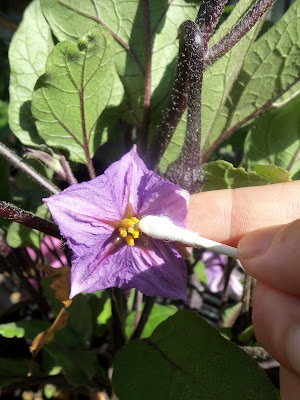It was the third week in July, and still no eggplants. My eggplant had been producing beautiful purple flower for weeks, but nothing was happening. No fruits! The bees have been hanging out near the carrots which doesn't even make sense.
After a little research, I'm attempting to alter 'mother-nature' myself. I'm tired of waiting, and ready to make all the amazing summer eggplant dishes on my list.

Eggplants (like tomatoes, peppers, and a few other veggies) are self-pollinating, meaning their flowers have both male and female parts. This means that they don't need bees to transfer the pollen from male flowers to female flowers--they can just do it themselves--but sometimes they need a little help. While eggplant flowers don't require bees to transfer pollen from another flower, the vibrations from the bee can help dislodge the pollen and move it to the stigma of the flower.
When the bees aren't around, you can do this yourself. With a q-tip (you can use a small brush or something like that) I rubbed the pollen from the stamen onto the pistil. If you need a refresher on your plant parts check out this diagram. Basically you want to rub the pollen from the long thick central yellow part to the stigma in the center. Watch out--many eggplant flowers have sharp thorns that will stab ya if you're not careful.
I repeated this process on all the flowers for two days in a row. The flower will eventually close, and look what happens in a few days! I have five baby eggplants. Yay! I feel like Medel himself, and am pretty proud of my botany back-yard experiment. Make sure you use a different q-tip on different eggplant varieties, otherwise you'll cross pollinate.
You can hand-pollinate other vegetables, but this process is a little different for "non-perfect" flowers like cucumbers, squash, pumpkins, and watermelon. Look for female blossoms on your plant that have an ovary just below the petals. Usually you'll only have few of these, and tons of male flowers nearby. You can either remove the male blossom and rub the pollen onto the stigma or center of the female blossom, or you can use a q-tip/brush to do the same thing. Similar to eggplants, the blossoms will also close, and a few days later you'll have a baby squash, ready to eat in no time.




This comment has been removed by the author.
ReplyDeleteGenius! So starting this tomm!!
ReplyDelete